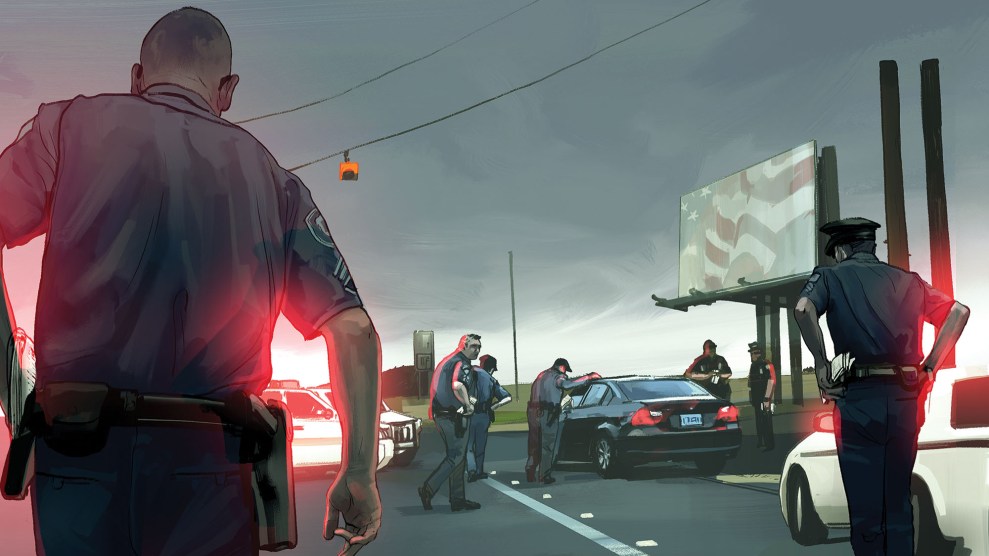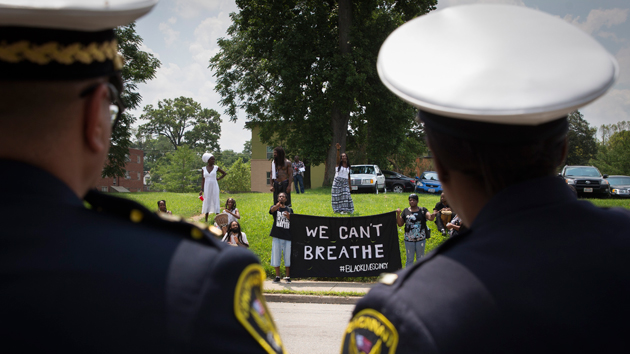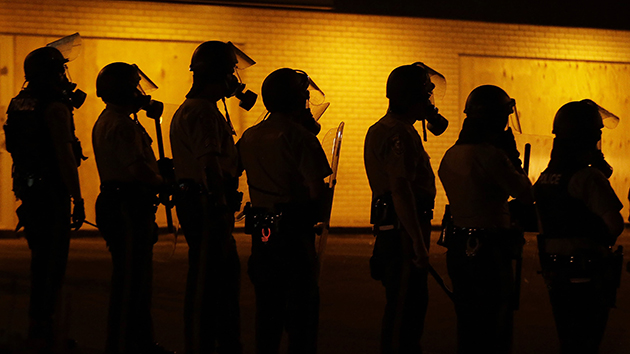
Owen Freeman
In April, several days after North Charleston, South Carolina, police officer Michael Slager stopped Walter Scott for a busted taillight and then fatally shot him, the usual cable-news transmogrification of victim into superpredator ran into problems. The dash cam showed Scott being pulled over while traveling at a nerdy rate of speed, using his left turn signal to pull into a parking lot and having an amiable conversation with Slager until he realized he’d probably get popped for nonpayment of child support. At which point he bolted out of the car and hobbled off. Slager then shot him. Why didn’t the cop just jog up and grab him? Calling what the obese 50-year-old Scott was doing “running” really stretches the bounds of literary license.
But maybe the question to ask is: Why did Scott run? The answer came when the New York Times revealed Scott to be a man of modest means trapped in an exhausting hamster wheel: He would get a low-paying job, make some child support payments, fall behind on them, get fined, miss a payment, get jailed for a few weeks, lose that job due to absence, and then start over at a lower-paying job. From all apparent evidence, he was a decent schlub trying to make things work in a system engineered to make his life miserable and recast his best efforts as criminal behavior.
Recently, two more deaths of African Americans that have blown up in the media follow a pattern similar to Scott’s. Sandra Bland in Texas and Samuel DuBose in Cincinnati were each stopped for minor traffic infractions (failing to use turn signal, missing front license plate), followed by immediate escalation by the officer into rage, and then an official story that is obviously contradicted by the video (that the officer tried to “de-escalate” the tension with Bland; that the officer was dragged by DuBose’s car). In both cases, the perpetrator of a minor traffic offense died.
When incidents of police violence come to light, the usual defense is that we should not tarnish all the good cops just because of “a few bad apples.” No one can argue with that. But what is usually implied in that phrase is that the “bad” officers’ intentions are malevolent—that they are morally corrupt and racist. And that may be true, but they are also bad in the job-performance sense. These men are crummy cops, sometimes profoundly so. Slager had a record for gratuitously using his Taser. Timothy Leohmann, who leapt from his car and instantly killed 12-year-old Tamir Rice, had been deemed “weepy” and unable to “emotionally function” by a supervisor at his previous PD job, who added: “I do not believe time, nor training, will be able to change or correct these deficiencies.” Ferguson’s Darren Wilson was also fired from his previous job—actually, the entire police force of Jennings, Missouri, was disbanded for being awful.
When you ask why such “bad” cops are nevertheless armed and allowed to patrol the streets, one begins to see that lurking beneath this violence is a fiscal menace: police departments forced to assist city officials in raising revenue, in many cases funding their own salaries—redirecting the very concept of keeping the peace into underwriting the budget.
We saw a glimpse of this when the Justice Department released its report on Ferguson in March. In his statement, then-Attorney General Eric Holder referenced a lady in town whose life sounded Walter Scott-like. She had received two parking tickets totaling $151. Her efforts to pay those fines fell so behind that she eventually paid out more than $500. At one point, she was jailed for nonpayment and—eight years later—still owes $541 in accrued fees.
The judge largely responsible for the extraction of these fees from Ferguson’s poor, Ronald J. Brockmeyer, owed $172,646 in back taxes, a sum orders of magnitude greater than any late fine coming before his bench. Even as he was jailing black ladies for parking tickets, Brockmeyer was allegedly erasing citations for white Ferguson residents who happened to be his friends. After the report’s publication, he resigned so that Ferguson could “begin its healing process.”
But consider: In 2010, this collaboration between the Ferguson police and the courts generated $1.4 million in income for the city. This year, they will more than double that amount—$3.1 million—providing nearly a quarter of the city’s $13 million budget, almost all of it extracted from its poorest African American citizens.
Evidence also suggests that this new form of raising revenue—policiteering?—goes far beyond Ferguson. Remember the recent Oklahoma case involving Robert Bates, a 73-year-old millionaire insurance broker with scant law enforcement background who was allowed to go out on patrol—likely because he had donated lots of money and equipment to the local sheriff’s office? He killed an unarmed black suspect when he grabbed his gun instead of his Taser. In the days that followed, we learned that other deputies had long resented this guy’s freelance incompetence.
“Essentially, these small towns in urban areas have municipal infrastructure that can’t be supported by the tax base, and so they ticket everything in sight to keep the town functioning,” said William Maurer, a lawyer with the Institute for Justice who has been studying the sudden rise in “nontraffic-related fines.”
Take the St. Louis suburb of Pagedale, where, among other Norman Rockwell-worthy features deemed illegal, “you can’t have a hedge more than three feet high,” Maurer says. “You can’t have a basketball hoop or a wading pool in front of a house. You can’t have a dish antenna on the front of your house. You can’t walk on the roadway if there is a sidewalk, and if there is not a sidewalk, they must walk on the left side of the roadway. They must walk on the right of the crosswalk. They can’t conduct a barbecue in the front yard and can’t have an alcoholic beverage within 150 feet of a barbecue. Kids cannot play in the street. They also have restrictions against pants being worn below the waist in public. Cars must be within 500 feet of a lamp or a source of illumination during nighttime hours. Blinds must be neatly hung in respectable appearance, properly maintained, and in a state of good repair.”
Where did this Kafkaesque laundry list come from? Maurer explains that in 2010, Missouri passed a law that capped the amount of city revenue that any agency could generate from traffic stops. The intent was to limit small-town speed traps, but the unintentional consequences are now clear: Pagedale saw a 495 percent increase in nontraffic-related arrests. “In Frontenac, the increase was 364 percent,” Maurer says. “In Lakeshire, it was 209 percent.”
This racket now has many variants. South Carolina hosts “Operation Rolling Thunder,” an annual dragnet in which 21 different law enforcement agencies swarm stretches of I-85 and I-26 in the name of catching drug dealers. In 2013, this law enforcement Bonnaroo netted 1,300 traffic citations and 300 speeding tickets. But after everyone had paid up, the operation boasted exactly one felony conviction.
A different strategy in San Diego simply tacks on various fees to an existing fine. A 2012 Union Tribune investigation revealed that while speeding is a simple $35 fine, other government agencies can tack on as many as 10 other surcharges, including: a state penalty assessment, $40; county penalty assessment, $36; court construction, $20; state surcharge, $8; DNA identification, $16; criminal conviction fee, $35; court operations, $40; emergency medical air transportation penalty, $4; and night court, $1. When it’s all said and done, that $35 ticket comes to $235.
Another report released earlier this year connects the dots: African Americans and Latinos make up less than a third of San Diego’s population but represent 64.5 percent of those searched during a traffic stop.
There is still no comprehensive study to determine just how many cities pay their bills by indenturing the poor, but it is probably no coincidence that when you examine the recent rash of police killings, you find that the offenses they were initially stopped for were preposterously minor. Bland’s lane change signal, DuBose’s missing plate. Walter Scott had that busted taillight—which, we all later learned, is not even a crime in South Carolina. Eric Garner was selling loose cigarettes. When Darren Wilson was called to look into a robbery, the reason he initially stopped Michael Brown was for walking in the street—in Ferguson, an illegal act according to Section 44-344 of the local code. Between 2011 and 2013, 95 percent of the perpetrators of this atrocity were African American, meaning that “walking while black” is not a punch line. It is a crime.
And not just a crime, but a crime that comes with fines that are strictly enforced. In 2014, Ferguson’s bottom-line-driven police force issued 16,000 arrest warrants to three-fourths of the town’s total population of 21,000. Stop and think about that for a moment: In Ferguson, 75 percent of all residents had active outstanding arrest warrants. Most of the entire city was a virtual plantation of indentured revenue producers.
Back in Pagedale, St. Louis Post-Dispatch reporter Jennifer Mann recently calculated a 500 percent increase in petty fines over the last five years. “Pagedale handed out 2,255 citations for these types of offenses last year,” Mann wrote, “or nearly two per household.”
“Once the system is primed for maximizing revenue—starting with fines and fine enforcement,” Holder said apropos Ferguson, “the city relies on the police force to serve, essentially, as a collection agency for the municipal court rather than a law enforcement entity.”
In Alabama, a circuit court judge, Hub Harrington, wrote a blistering opinion three years ago asserting that the Shelby County Jail had become a kind of “debtors’ prison” and that the court system had devolved into a “judicially sanctioned extortion racket.” This pattern leads to a cruel paradox: One arm of the state is paying a large sum to lock up a person who can’t pay a small sum owed to a different arm of the state. The result? Bigger state deficits. As the director of the Brennan Center’s Justice Program put it, “Having taxpayers foot a bill of $4,000 to incarcerate a man who owes the state $745 or a woman who owes a predatory lender $425 and removing them from the job force makes sense in no reasonable world.”
When the poor come to understand that they are likely to be detained and fined for comically absurd crimes, it can’t be a surprise to the police that their officers are viewed with increasing distrust. In this environment, running away from a cop is not an act of suspicion; it’s common sense.
Cops like to talk about “good police.” They say, “That guy is good police”—a top compliment, by which they mean cool under the pressure of the street and cunning at getting people to give up the details of a crime. Good police look bad when sharing the street with crummy police. But when budgetary whims replace peacekeeping as the central motivation of law enforcement, who is more likely to write up more tickets, the good cop or the crummy one? When the mission of the entire department shifts from “protect and serve” to “punish and profit,” then just what constitutes good police?













